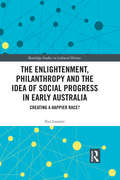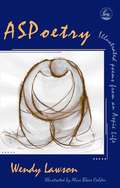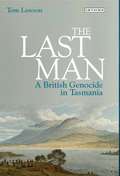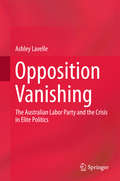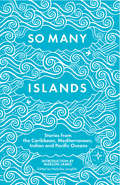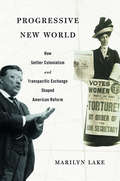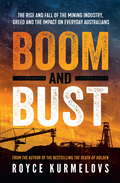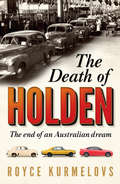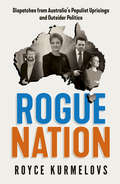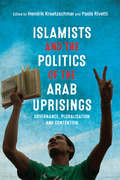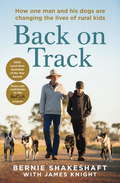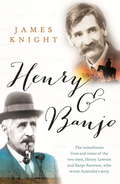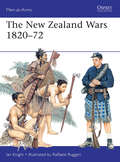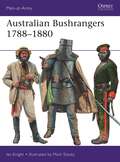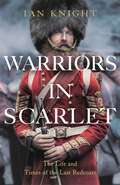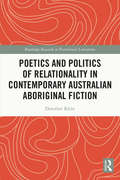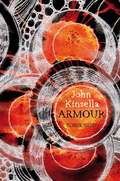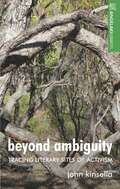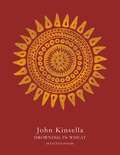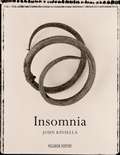- Table View
- List View
The Enlightenment, Philanthropy and the Idea of Social Progress in Early Australia: Creating a Happier Race? (Routledge Studies in Cultural History #63)
by Ilya LazarevThis book seeks to highlight the influence of the Enlightenment idea of social progress on the character of the "civilising mission" in early Australia by tracing its presence in the various "civilising" attempts undertaken between 1788 and 1850. It also represents an attempt to marry the history of the British Enlightenment and the history of settler-Aboriginal interactions. The chronological structure of the book, as well as the breadth of its content, will facilitate the readers’ understanding of the evolution of "civilising attempts" and their epistemological underpinnings, while throwing additional light on the influence of the Enlightenment on Australian history as a whole.
ASPoetry: Illustrated poems from an Aspie Life (PDF)
by Wendy LawsonWendy Lawson's well-known poetry reflects the many aspects of a life lived with Asperger's Syndrome. In this illustrated collection of poems and short prose pieces, including some from her childhood and teenage years, Wendy engages with her past and present, writing frankly about childhood, self-discovery, adulthood and friendship. Her poetry also conveys the day-to-day challenges presented by divorce, bereavement, emigration, disclosing homosexuality and Asperger's Syndrome. Both reflective and life affirming, these poems offer evocative glimpses of the Asperger experience and will enrich readers' understanding of autism spectrum disorders.
The Last Man: A British Genocide in Tasmania
by Tom LawsonLittle more than seventy years after the British settled Van Diemen's Land (later Tasmania) in 1803, its indigenous population had been virtually wiped out. Yet this genocide - one of the earliest of the modern era - is virtually forgotten in Britain today. The Last Man is the first book specifically to explore the role of the British government and wider society in the destruction of the Aboriginal Tasmanians. Although the introduction of European diseases undoubtedly contributed to the decline of the indigenous population, Tom Lawson shows that Britain supported what was effectively the ethnic cleansing of Tasmania - particularly in the period of martial law in 1828-1832. He also illustrates the ways in which the destruction of indigenous Tasmanians was reflected in British culture - both at the time and since - and how it came to play a key part in forging particular versions of British imperial identity. The Last Man provides the first comprehensive picture of Britain's role in the destruction of the Tasmanian Aboriginal population.
Opposition Vanishing: The Australian Labor Party and the Crisis in Elite Politics
by Ashley LavelleThis book questions the common understanding of party political behaviour, explaining some of the sharp differences in political behaviour through a focused case study—drawing systematically on primary and archival research—of the Australian Labor Party’s political and policy directions during select periods in which it was out of office at the federal level: from 1967–72, 1975–83, and 1996–2001. Why is it that some Oppositions contest elections with an extensive array of detailed policies, many of which contrast with the approach of the government at the time, while others can be widely criticised as ‘policy lazy’ and opportunistic, seemingly capitulating to the government of the day? Why do some Oppositions lurch to the right, while others veer leftward? Each of these periods was, in its own way, crucial in the party’s history, and each raises important questions about Opposition behaviour. The book examines the factors that shaped the overall direction in which the party moved during its time in Opposition, including whether it was oriented towards emphasising programmes traditionally associated with social democrats, such as pensions, unemployment support, and investment in public health, education, infrastructure, and publicly owned enterprises, as well as policies aimed at reducing the exploitation of workers. In each period of Opposition examined, an argument is made as to why Labor moved in a particular direction, and how this period compared to the other periods surveyed. The book rounds off with analysis of the generalisability of the conclusions drawn: how relevant are they for understanding the behaviour of other parties elsewhere in the world? Where are social democratic parties such as the ALP heading? Is Opposition an institution in decline in the Western world?
So Many Islands: Stories from the Caribbean, Mediterranean, Indian and Pacific Oceans
by Nicholas Laughlin Nailah Folami ImojaSo Many Islands breaks out bold new writing from the distant shores of countries in the Caribbean, Mediterranean, Indian and Pacific oceans. Here you will find poems about revolution and protest. You will be transported to Marakei, ‘the women’s island’, and join the battle to save a beached whale. Alongside family politics, So Many Islands tackles nuclear testing and climate change – global issues that are close to the heart of these precariously poised communities. Giving voice to their challenges and triumphs, these writers create a vibrant portrait of what it is like to live and love on the small islands they call home. Readers everywhere will find universal connections with their words and worlds. Antigua and Barbuda, Barbados, Bermuda, Cyprus, Grenada, Jamaica, Kiribati, Malta, Mauritius, Niue, Rotuma (Fiji), Samoa, Singapore, Saint Lucia, Saint Vincent and the Grenadines, Tonga, Trinidad and Tobago
Progressive New World: How Settler Colonialism and Transpacific Exchange Shaped American Reform
by Marilyn LakeIn a bold argument, Marilyn Lake shows that race and reform were mutually supportive as Progressivism became the political logic of settler colonialism at the turn of the 20th century. She points to exchanges between American and Australasian reformers who shared racial sensibilities, along with a commitment to forging an ideal social order.
Progressive New World: How Settler Colonialism and Transpacific Exchange Shaped American Reform
by Marilyn LakeIn a bold argument, Marilyn Lake shows that race and reform were mutually supportive as Progressivism became the political logic of settler colonialism at the turn of the 20th century. She points to exchanges between American and Australasian reformers who shared racial sensibilities, along with a commitment to forging an ideal social order.
Boom and Bust: The rise and fall of the mining industry, greed and the impact on everyday Australians
by Royce KurmelovsThis is a cautionary tale. About greed, irresponsibility and failing to learn from the past.Australia's mining boom is still talked about with a sense of awe. This once-in-a-lifetime event capped off 25 straight years of economic growth. Thanks to mining we sidestepped the worst of the Global Financial Crisis. To the rest of the world Australia was an economic miracle. And then the boom ended.Now Australia is grappling with what that means at a time of rising economic inequality and political upheaval. The end of the boom isn't about money - it's about people. Boom and Bust looks at what happens to those who came into vast wealth only to watch it dry up. To those who thought they had a good job for life, but didn't. The bust didn't just happen on stock-market screens - it was lived, and is still being lived right now, in dusty towns and cities all around the country.As he did in his bestselling book The Death of Holden, Royce Kurmelovs reveals the reality behind the headlines. Boom and Bust is a dirt-under-the-nails look at the winners, the losers and the impact of the boom that wasn't meant to end. This is a book all Australians should read.'Brilliant and powerful' Nick Xenophon on Royce Kurmelovs' THE DEATH OF HOLDEN
The Death of Holden: The bestselling account of the decline of Australian manufacturing
by Royce KurmelovsHolden is one of the few brands that has an emotional grip on Australia (Qantas being another). The closure of the Holden factory in Adelaide is not just the end of a business - it's the end of an era, of a story, and of a great Australian dream.When Holden signalled that it would close its Adelaide factory, it struck at the very heart of Australian identity. Holden is our car made on our shores. It's the choice of patriotic rev heads and suburban drivers alike. How could a car that was so beloved - and so popular - be so unprofitable to make?The story of the collapse of Holden is about the people who make and drive the cars; it's about sustaining industry in Australia; it's about communities of workers and what happens when the work dries up. And if it's not quite about the death of an icon - because Holdens will remain on Australian roads for a long time to come - then it's about what happens when an icon falls to knees in front of a whole nation.'Brilliant and powerful' Nick Xenophon
Rogue Nation: Fascinating, relevant, compelling – the one book about Australian politics you must read
by Royce KurmelovsReporting from the backrooms and corridors of Parliament House in Canberra to the streets of post-industrial Burnie in Tasmania, the struggling rural communities of Gippsland and the Queensland heartland, Royce Kurmelovs captures with perceptive, real-time analysis the rise of Australian populism.The people and places he profiles tell the story of those independent political figures who have tried to take power from the outside and those who feel abandoned by both the left and right of politics. Overshadowing it all is the controversial figure of Pauline Hanson, a woman who came back from oblivion to become a powerbroker just as the country breathlessly watched the election of Donald Trump and wondered whether the same could happen here. ROGUE NATION is essential reading for anyone who wants to know what is happening to politics in this country, and what the future might hold.
Islamists and the Politics of the Arab Uprisings: Governance, Pluralisation and Contention
by Hendrik Kraetzschmar Paola RivettiTraces Scotland's changing townscapes over a thousand years
Islamists and the Politics of the Arab Uprisings: Governance, Pluralisation and Contention (Edinburgh University Press)
by Hendrik Kraetzschmar Paola RivettiDemonstrates how the textual output of settler emigration shapes the nineteenth-century literary and artistic imagination
Back on Track: How one man and his dogs are changing the lives of rural kids
by James Knight Bernie ShakeshaftAs a kid, Bernie Shakeshaft's mischievous and reckless behaviour led him to became known as the wild one of his devout Catholic family. It isn't surprising that his path led him to the Northern Territory, a place where people often go to either lose themselves or find themselves. Bernie, a searcher for his purpose in life, found himself.He had many jobs, firstly as a ringer on a cattle station owned by the Packer family, and later as a dingo trapper for the Parks and Wildlife Service. Throughout it all, he drank, he swore, he fought, and took chances with his own well-being. But, crucially, he also developed deep connections with the Indigenous people, and it was these connections that helped lay the foundations for what was to come. He worked for youth welfare organisations, and all the while he built up his knowledge about helping wayward youths, particularly those from Indigenous communities.Years later, Bernie was living in Armidale. He'd been visiting too many kids in prison and going to too many funerals. The usual methods weren't working so that reckless, mischievous kid inside him decided he could do better. He started a youth program called BackTrack, with three aims: To keep them alive, out of jail and chasing their hopes and dreams. For most, this was their last chance. Combining life skills, education, job preparedness with rural work, Bernie threw in one other factor: dogs! And it works. With the help of these working dogs, the lost boys (and girls) find their way back on track. These days, Backtrack youth tour the country competing in dog-jumping trials. Bernie and the BackTrack team are now supporting other communities in Lake Cargelligo, Broken Hill, Dubbo and Grafton and have forged a new beginning for over 1000 young people. This one man is making a huge difference.In Back on Track, bestselling author James Knight tells Bernie's story and the stories of those whose lives he has saved. It is a powerful reminder that we should never give up on our kids.'This fella Bernie, he's a good fella, a bit of a genius really. What a great story.' - Russell Crowe
Henry and Banjo: The Tumultuous Lives And Times Of Henry Lawson And Banjo Paterson, The Men Who Wrote Australia's History
by James KnightThe fascinating lives and turbulent times of Henry Lawson and Andrew 'Banjo' Paterson - the two men who wrote Australia's story.Today most of us know that Henry Lawson and Andrew 'Banjo' Paterson were famous writers. We know about Matilda, Clancy of the Overflow and the Man from Snowy River; The Drover's Wife, While the Billy Boils and Joe Wilson and his mates, but little else. Here, in a compelling and engaging work, James Knight brings Henry and Banjo's own stories to life. And there is much to tell.Both were country born, just three years and three hundred kilometres apart, Henry on the goldfields of Grenfell and Banjo on a property near Orange, but their paths to literary immortality took very different routes - indeed at times their lives were ones of savage and all too tragic contrasts. Banjo, born into a life of comparative privilege, would rise from country boy to Sydney Grammar student, solicitor, journalist, war correspondent and revered man about town. Henry's formal education only began when his feminist mother finally won her battle for a local school but illness and subsequent deafness would make continuing his lessons difficult, seeing him find work as a labourer, a coach painter and a journalist, all the while wrestling with poverty, alcoholism and mental illness. Both men would become household names during their lifetimes. Both would have regrets.Henry and Banjo details two incredibly fascinating lives and delves into the famous (and not so famous) writings of the two men who had the power to influence and change Australia.
The New Zealand Wars 1820–72 (Men-at-Arms #487)
by Ian Knight Mr Raffaele RuggeriBetween 1845 and 1872, various groups of Maori were involved in a series of wars of resistance against British settlers. The Maori had a fierce and long-established warrior tradition and subduing them took a lengthy British Army commitment, only surpassed in the Victorian period by that on the North-West Frontier of India. Warfare had been endemic in pre-colonial New Zealand and Maori groups maintained fortified villages or pas. The small early British coastal settlements were tolerated, and in the 1820s a chief named Hongi Hika travelled to Britain with a missionary and returned laden with gifts. He promptly exchanged these for muskets, and began an aggressive 15-year expansion. By the 1860s many Maori had acquired firearms and had perfected their bush-warfare tactics. In the last phase of the wars a religious movement, Pai Maarire ('Hau Hau'), inspired remarkable guerrilla leaders such as Te Kooti Arikirangi to renewed resistance. This final phase saw a reduction in British Army forces. European victory was not total, but led to a negotiated peace that preserved some of the Maori people's territories and freedoms.
Australian Bushrangers 1788–1880 (Men-at-Arms)
by Ian KnightThe first 'bushrangers' or frontier outlaws were escaped or time-expired convicts, who took to the wilderness – 'the bush' – in New South Wales and on the island of Tasmania. Initially, the only Crown forces available were redcoats from the small, scattered garrisons, but by 1825 the problem of outlawry led to the formation of the first Mounted Police from these soldiers. The gold strikes of the 1860s attracted a new group of men who preferred to get rich by the gun rather than the shovel. The roads, and later railways, that linked the mines with the cities offered many tempting targets and were preyed upon by the bushrangers. This 1860s generation boasted many famous outlaws who passed into legend for their boldness. The last outbreak came in Victoria in 1880, when the notorious Kelly Gang staged several hold-ups and deliberately ambushed the pursuing police. Their last stand at Glenrowan has become a legendary episode in Australian history. Fully illustrated with some rare period photographs, this is the fascinating story of Australia's most infamous outlaws and the men tasked with tracking them down.
Australian Bushrangers 1788–1880 (Men-at-Arms)
by Ian KnightThe first 'bushrangers' or frontier outlaws were escaped or time-expired convicts, who took to the wilderness – 'the bush' – in New South Wales and on the island of Tasmania. Initially, the only Crown forces available were redcoats from the small, scattered garrisons, but by 1825 the problem of outlawry led to the formation of the first Mounted Police from these soldiers. The gold strikes of the 1860s attracted a new group of men who preferred to get rich by the gun rather than the shovel. The roads, and later railways, that linked the mines with the cities offered many tempting targets and were preyed upon by the bushrangers. This 1860s generation boasted many famous outlaws who passed into legend for their boldness. The last outbreak came in Victoria in 1880, when the notorious Kelly Gang staged several hold-ups and deliberately ambushed the pursuing police. Their last stand at Glenrowan has become a legendary episode in Australian history. Fully illustrated with some rare period photographs, this is the fascinating story of Australia's most infamous outlaws and the men tasked with tracking them down.
Warriors in Scarlet: The Life and Times of the Last Redcoats
by Ian KnightIan Knight's Warriors in Scarlet is a comprehensive and stirring history of the Victorian army between 1837 to 1860, from the Battle of Bossendon Wood to the Crimean War, a period of seismic change as the rapid expansion of the empire saw the British army fighting in small wars across the world.An acclaimed military historian, Knight reveals the brutal reality of colonial conflict from both sides. Drawing on first-hand accounts he shows us the reality of life for the British soldier in this era – the drudgery of peacetime service for the ordinary soldier, the excitement and privations of posting overseas, the floggings and desertions, the regimental pride and comradeship.Knight vividly recreates the action on the ground, from bloody skirmishes in Southern Africa and siege warfare in New Zealand to disasters like the 1842 retreat from Kabul and Chillianwalla in the Punjab. British soldiers trained in tactics that had beaten Napoleon were forced to adapt when faced with warriors with very different skills fighting on their home ground, and yet the army won more than four-fifths of the battles they fought in this era. Knight describes how, by 1860 with their redcoats increasingly replaced by khaki, the British army was a more professional, efficient and increasingly ruthless fighting force.'Impressively researched and highly readable analysis' – Tony Pollard, Professor of Conflict History and Archaeology, University of Glasgow
Poetics and Politics of Relationality in Contemporary Australian Aboriginal Fiction (Routledge Research in Postcolonial Literatures)
by Dorothee KleinPoetics and Politics of Relationality in Contemporary Australian Aboriginal Fiction is the first sustained study of the formal particularities of works by Bruce Pascoe, Kim Scott, Tara June Winch, and Alexis Wright. Drawing on a rich theoretical framework that includes approaches to relationality by Aboriginal thinkers, Edouard Glissant, and Jean-Luc Nancy, and recent work in New Formalism and narrative theory, it illustrates how they use a broad range of narrative techniques to mediate, negotiate, and temporarily create networks of relations that interlink all elements of the universe. Through this focus on relationality, Aboriginal writing gains both local and global significance. Locally, these narratives assert Indigenous sovereignty by staging an unbroken interrelatedness of people and their Land. Globally, they intervene into current discourses about humanity’s relationship with the natural environment, urging readers to acknowledge our interrelatedness with and dependence on the land that sustains us.
Poetics and Politics of Relationality in Contemporary Australian Aboriginal Fiction (Routledge Research in Postcolonial Literatures)
by Dorothee KleinPoetics and Politics of Relationality in Contemporary Australian Aboriginal Fiction is the first sustained study of the formal particularities of works by Bruce Pascoe, Kim Scott, Tara June Winch, and Alexis Wright. Drawing on a rich theoretical framework that includes approaches to relationality by Aboriginal thinkers, Edouard Glissant, and Jean-Luc Nancy, and recent work in New Formalism and narrative theory, it illustrates how they use a broad range of narrative techniques to mediate, negotiate, and temporarily create networks of relations that interlink all elements of the universe. Through this focus on relationality, Aboriginal writing gains both local and global significance. Locally, these narratives assert Indigenous sovereignty by staging an unbroken interrelatedness of people and their Land. Globally, they intervene into current discourses about humanity’s relationship with the natural environment, urging readers to acknowledge our interrelatedness with and dependence on the land that sustains us.
Armour
by John KinsellaWith Armour, the great Australian poet John Kinsella has written his most spiritual work to date – and his most politically engaged. The world in which these poems unfold is strangely poised between the material and the immaterial, and everything which enters it – kestrel and fox, moth and almond – does so illuminated by its own vivid presence: the impression is less a poet honouring his subjects than uncannily inhabiting them. Elsewhere we find a poetry of lyric protest, as Kinsella scrutinizes the equivocal place of the human within this natural landscape, both as tenant and self-appointed steward. Armour is a beautifully various work, one of sharp ecological and social critique – but also one of meticulous invocation and quiet astonishment, whose atmosphere will haunt the reader long after they close the book. Praise for John Kinsella: ‘Kinsella’s poems are a very rare feat: they are narratives of feeling. Vivid sight – of landscapes, of animals, of human forms in distant light – becomes insight. There is, often, the shock of the new. But somehow awaited, even familiar. Which is the homecoming of a true poet’ George Steiner
Beyond ambiguity: Tracing literary sites of activism (Angelaki Humanities)
by John KinsellaThis volume completes John Kinsella’s trilogy of critical activist poetics, begun two decades ago. It challenges familiar topoi and normatives of poetic activity as it pertains to environmental, humanitarian and textual activism in ‘the world-at-large’: it shows how ambiguity can be a generative force when it works from a basis of non-ambiguity of purpose. The book shows how there is a clear unambiguous position to have regarding issues of justice, but that from that confirmed point ambiguity can be an intense and useful activist tool. The book is an essential resource for those wishing to study Kinsella, and for those with an interest in twentieth and twenty-first-century poetry and poetics, and it will stand as an inspiring proclamation of the author's faith in the transformative power of poetry and literary activity as a force for good in the world.
Beyond ambiguity: Tracing literary sites of activism (Angelaki Humanities)
by John KinsellaThis volume completes John Kinsella’s trilogy of critical activist poetics, begun two decades ago. It challenges familiar topoi and normatives of poetic activity as it pertains to environmental, humanitarian and textual activism in ‘the world-at-large’: it shows how ambiguity can be a generative force when it works from a basis of non-ambiguity of purpose. The book shows how there is a clear unambiguous position to have regarding issues of justice, but that from that confirmed point ambiguity can be an intense and useful activist tool. The book is an essential resource for those wishing to study Kinsella, and for those with an interest in twentieth and twenty-first-century poetry and poetics, and it will stand as an inspiring proclamation of the author's faith in the transformative power of poetry and literary activity as a force for good in the world.
Drowning in Wheat: Selected Poems
by John KinsellaDrowning in Wheat collects the best of three decades of John Kinsella's astonishing poetry in one volume. Kinsella is universally acknowledged as one of the greatest living Australian poets, and arguably the most important 'eco-poet' of the age; however, this collection also reveals a writer of unexpected and remarkable versatility, and one fluent in an almost bewildering range of forms, registers and voices. Despite its great thematic range, Kinsella's overarching project emerges all the more clearly: Drowning in Wheat is a clarion call and a call to order, a plea to listen to the earth - and to understand our own place within it while we still can. It is also an ideal introduction to one of the essential poets of the age.
Insomnia
by John KinsellaThe Australian poet John Kinsella’s vivid and urgent new collection addresses the crisis of being that currently afflicts us: Kinsella addresses a situation where the creations of the human imagination, the very means by which we extend our empathies into the world – art, music and philosophy – suddenly find themselves in a world that not only denies their importance, but can sometimes seem to have no use for them at all. In an attempt to find a still point from which we might reconfigure our perspective and address the paradoxes of our contemporary experience, Kinsella has written poems of self-accusation and angry protest, meditations on the nature of loss and trauma, and full-throated celebrations of the natural world. Ranging from Jam Tree Gully, Western Australia to the coast of West Cork, Ireland, haunted by historical and literary figures from Dante to Emily Brontë (whom Kinsella has obsessed over since he was a child, and who intervenes in the poet’s attempts to come to grips with ideas of colonization and identity), Insomnia may be Kinsella’s most various and powerful collection to date.
